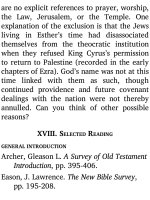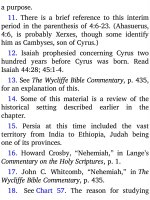Jensens survey of the old testament adam 407
Bạn đang xem bản rút gọn của tài liệu. Xem và tải ngay bản đầy đủ của tài liệu tại đây (83.7 KB, 4 trang )
Authors of many Bible books are not
identi ed by name. This is so in the case of
the gospel of John. The traditional view is
that John the apostle, sometimes referred to
as John the evangelist, was the author;
hence the title, gospel of John, or gospel
according to John.1 (The titles of our Bible
books were not a part of the originally
inspired text, but were added later for
identi cation purposes.) According to 21:20,
23-24, the “disciple whom Jesus loved” was
the author. Read 13:23; 19:26; 20:2; 21:7
for other similar descriptions of this disciple.
In each case, John could be the disciple
meant. If John was the author, why do you
suppose he would not name himself in those
passages?
Listed below are some descriptions and
other facts concerning the apostle John.
Study these carefully to become acquainted
with the author. Be sure to read all verses
cited.
1. Family
a. John was a son of Zebedee (21:2) and
Salome (cf. Matt. 27:56; Mark 15:40; John
19:25). Since Salome was a sister of Jesus’
mother Mary, Jesus and John were cousins.
That would partly explain the close
association between the two.
b. John was a brother of the apostle
James. Jesus surnamed both men Boanerges,
or “sons of thunder,” a name indicating
perhaps a ery personality (cf. Luke 9:5256).
c. Zebedee, James, and John were
shermen at the Sea of Galilee. Zebedee was
probably well-to-do (Mark 1:19-20).
2. Christian ministry
a. John may have been a disciple of
John the Baptist when Jesus called him to
His service (Mark 1:20). His age at that time
may have been around twenty- ve, and he
lived to be about one hundred.
b. John was a Palestinian Jew, a close
companion of Peter, a contemporary of the
events of his gospel.
c. John became a leader of the
Jerusalem church (Gal. 2:9).
3. Writings
John wrote three epistles and
Revelation in addition to his gospel. Because
Revelation refers mainly to the last days, the
statement may be made that, as John the
Baptist prepared the way for the
rst
coming of Jesus, the apostle John has
prepared the way for Christ’s second
coming.
4. Later life
There are only a few historical
references to John after the events of the
gospels. Read these:
Acts 4:1-22; 8:14-15 — John with Peter
Galatians 2:9
— One of John’s contacts with Paul
Revelation 1:1, 4, 9 — John’s exile experience, around A.D. 95
5. Character
From New Testament biography and
epistles, a composite personality image of
John is seen, though the image is
incomplete in some respects. John was a
man of courage, fervor, loyalty, spiritual
perception, love, and humility. The subject
of love is a keynote of his epistles. Of this
Merrill Tenney writes, “As Christ tamed his
ardor and puri ed it of unrestrained
violence, John became the apostle of love
whose devotion was not excelled by that of
any other writer of the New Testament.”2
(See 1 John 4:7.)









